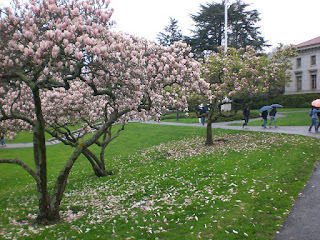The
cool summer breeze puts a blanket of chill over your skin. It is not cold
enough to shiver, but it isn’t warm enough to perspire. All the while, the
squawking of seagulls fills the salty air. Let us go on a tour of the
birthplace.
We are now in the belly of the monster:
The University of California, Berkley. The gates that surround the university
make it seem almost closed off to the world’s opportunities. However, what was
discovered at this lab will surely expand science.
 |
| Chien, Leonard. "spring flowers" 03/03/09 via flickr Attribution-NonCommercial-ShareAlike 2.0 Generic |
The building and the laboratory do
not match in style. The door creaks louder than the “scary doors” you see in
movies. As soon as you are inside, a world of possibilities unfolds before your
eyes. The place seems to be a wonderland with brighter colors than you could
ever imagine. Most of the colors are a vibrant yellow that put forth joy and opportunity
in your heart. What you see before you are not an amusement park but a
laboratory.
Not only does it look like a main
attraction but it feels like a main
attraction. There are dozens of people buzzing all over the laboratory. This is
much like a scene you’d see at the center of a bee hive. These kinds of bees
have lab coats on and graduate degrees in their hands. The king bee of the
entire operation is Jennifer Doudna (who co-discovered CRISPR/Cas-9). The noise
of the entire place almost drowns itself out so that you have a quiet mind.
The modern inside appears to have no
odor to it at first sniff. However, as you get further in to the lab, your nose
starts to crinkle as the scents of seemingly strong vinegar fill the air. Rest
assured, those are actually toxic acids that you’re smelling.
No comments:
Post a Comment